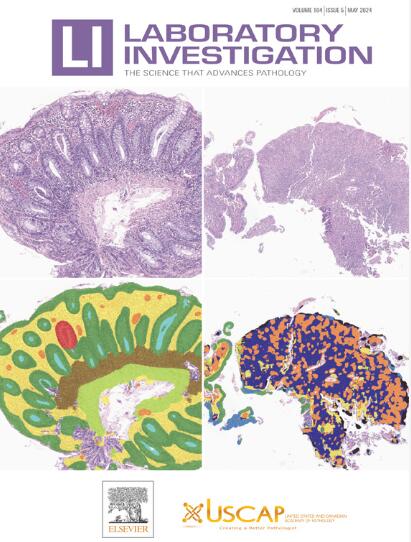Deep Learning–Guided Quantitative Analysis Establishes Optimized BRAF V600E Immunohistochemical Criteria for Colorectal Cancer: A Multiplatform Validation Study
IF 4.2
2区 医学
Q1 MEDICINE, RESEARCH & EXPERIMENTAL
引用次数: 0
Abstract
Accurate detection of BRAF V600E mutation is critical for guiding therapeutic strategies. Unlike other solid tumors, colorectal cancer (CRC) lacks reliable immunohistochemical (IHC) interpretation criteria. This study aimed to establish CRC-specific IHC criteria through quantitative analysis. A cohort of 250 CRC cases with paired IHC and genetic testing (qPCR and next-generation sequencing) results was analyzed. Cross-platform generalization capability of 3 BRAF V600E antibodies was validated. Previously reported IHC criteria were applied and discordant cases were analyzed. A deep learning–based digital pathology platform quantified IHC parameters (H-score, staining intensity, and percentage). Receiver-operating characteristic analysis identified optimal thresholds, which were translated into practical criteria. External validation was performed to confirm generalizability. Cross-platform validation revealed consistent antibody performance across platforms, with absorbance optical density (2.0-2.3) and H-scores (145-160) showing no significant intergroup differences (P > .05). Initial comparison of existing criteria demonstrated 80.4% to 84.8% concordance with molecular testing. Discordant cases exhibited 5 distinct abnormal staining patterns. Artificial intelligence–driven quantification identified H-score 52.675 as the optimal upper cutoff (area under the curve [AUC], 0.938), translated into a positive criterion of >25% 2+ or >15% 3+ stained cells. A negative criterion of <20% 1+ cells was established. Cases with atypical staining patterns required molecular confirmation. The optimized criteria achieved superior concordance in internal (AUC, 0.932) and external validation (AUC, 0.977). This study established refined BRAF V600E IHC criteria for colorectal cancer using precision quantitative analysis. The optimized protocol significantly improves accuracy and standardization in complex real-world scenarios, demonstrating strong potential for broad clinical adoption.
深度学习引导的定量分析建立了优化的BRAF V600E结直肠癌免疫组织化学标准:一项多平台验证研究
目的:准确检测BRAF V600E突变对指导治疗策略至关重要。与其他实体肿瘤不同,结直肠癌(CRC)缺乏可靠的免疫组织化学(IHC)解释标准。本研究旨在通过定量分析建立crc特异性免疫组化标准。方法:对250例结直肠癌患者的免疫组化和基因检测(qPCR和NGS)结果进行分析。验证了三种BRAF V600E抗体的跨平台泛化能力。应用先前报道的IHC标准,分析不一致的病例。基于深度学习的数字病理平台量化IHC参数(h评分、染色强度和百分比)。ROC分析确定了最佳阈值,并将其转化为实际标准。进行外部验证以确认可推广性。结果:跨平台验证显示抗体在不同平台上表现一致,吸光度光密度(AOD: 2.0 ~ 2.3)和h分数(145 ~ 160)组间差异无统计学意义(P < 0.05)。初步比较现有标准与分子检测的符合率为80.4% ~ 84.8%。不一致的病例表现出五种不同的异常染色模式。人工智能驱动的定量鉴定h评分52.675为最佳上临界值(AUC: 0.938),转化为>25% 2+或>15% 3+染色细胞的阳性标准。结论:本研究通过精确定量分析,建立了完善的BRAF V600E结直肠癌IHC标准。优化后的方案显着提高了复杂现实场景的准确性和标准化,显示出广泛临床应用的强大潜力。
本文章由计算机程序翻译,如有差异,请以英文原文为准。
求助全文
约1分钟内获得全文
求助全文
来源期刊

Laboratory Investigation
医学-病理学
CiteScore
8.30
自引率
0.00%
发文量
125
审稿时长
2 months
期刊介绍:
Laboratory Investigation is an international journal owned by the United States and Canadian Academy of Pathology. Laboratory Investigation offers prompt publication of high-quality original research in all biomedical disciplines relating to the understanding of human disease and the application of new methods to the diagnosis of disease. Both human and experimental studies are welcome.
 求助内容:
求助内容: 应助结果提醒方式:
应助结果提醒方式:


